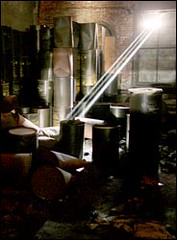Time capsule
City workers were conducting a regular structural inspection of the [Brooklyn [B]ridge last Wednesday when they came across the cold-war-era hoard of water drums, medical supplies, paper blankets, drugs and calorie-packed crackers — an estimated 352,000 of them, sealed in dozens of watertight metal canisters and, it seems, still edible.
To step inside the vault — a dank and lightless room where the walls are lined with dusty boxes — is to be vividly reminded of the anxieties that dominated American life during the military rivalry with the Soviet Union, an era when air-raid sirens and fallout shelters were standard elements of the grade-school curriculum.
Several historians said yesterday that the find was exceptional, in part because many of the cardboard boxes of supplies were ink-stamped with two especially significant years in cold-war history: 1957, when the Soviets launched the Sputnik satellite, and 1962, when the Cuban missile crisis seemed to bring the world to the precipice of nuclear destruction.
[...]For the officials who gave the tour, the discovery set off some strong memories. Judith E. Bergtraum, the department's first deputy commissioner, recalled air-raid drills — "first it was under the desk and then it was in the hall" — at Public School 165 in Queens. Russell Holcomb, a deputy chief bridge engineer, remembered watching Nikita Khrushchev pounding his shoe at the United Nations in 1960 on television.
Several of the boxes in the room have labels from the Office of Civil Defense, a unit of the Pentagon that coordinated domestic preparedness in the early 1960's. State and local governments often appointed their own civil-defense coordinators, said Graham T. Allison, a former assistant secretary of defense who teaches at the Kennedy School of Government at Harvard.
Dr. Allison acknowledged that fallout shelters would probably have been ineffective in the event of nuclear war but that the precautions were comforting.
"At least people would think they were doing something, even if it didn't have any effect," he said.
In 1950, the city's Office of Civil Defense, the predecessor to today's Office of Emergency Management, was formed to prepare for a possible atomic attack. In 1951, during the Korean War, floodlights and barbed-wire barriers were set up on and around the city's bridges, and bridge operators were organized into defense batteries, as part of an overall civil-defense strategy aimed at deterring sabotage.
Mayor Robert F. Wagner, who served from 1954 to 1965, appointed several civil-defense advisers. In 1959, a federal report concluded that two hydrogen bombs dropped near the Brooklyn Bridge would kill at least 6.1 million people.
Oh yeah, that's right, they're probably howling that we'd better start setting up those "defense bateries" again, in case the Islamofascists start launching ICBMs full of suicide bombers at us.
But what goes unanswered in the story, if the workers who found the room were conducting a "regular structural inspection," how come they're just coming across this now, fifty years later?



0 Comments:
Post a Comment
<< Home